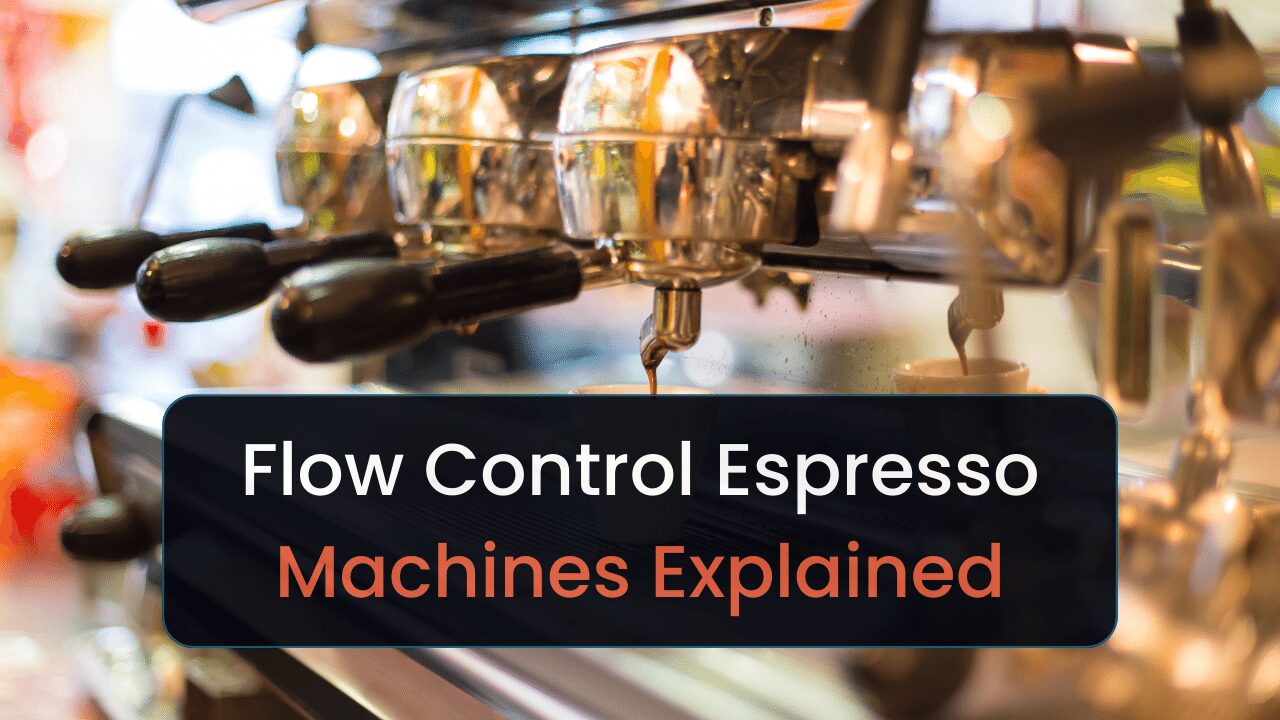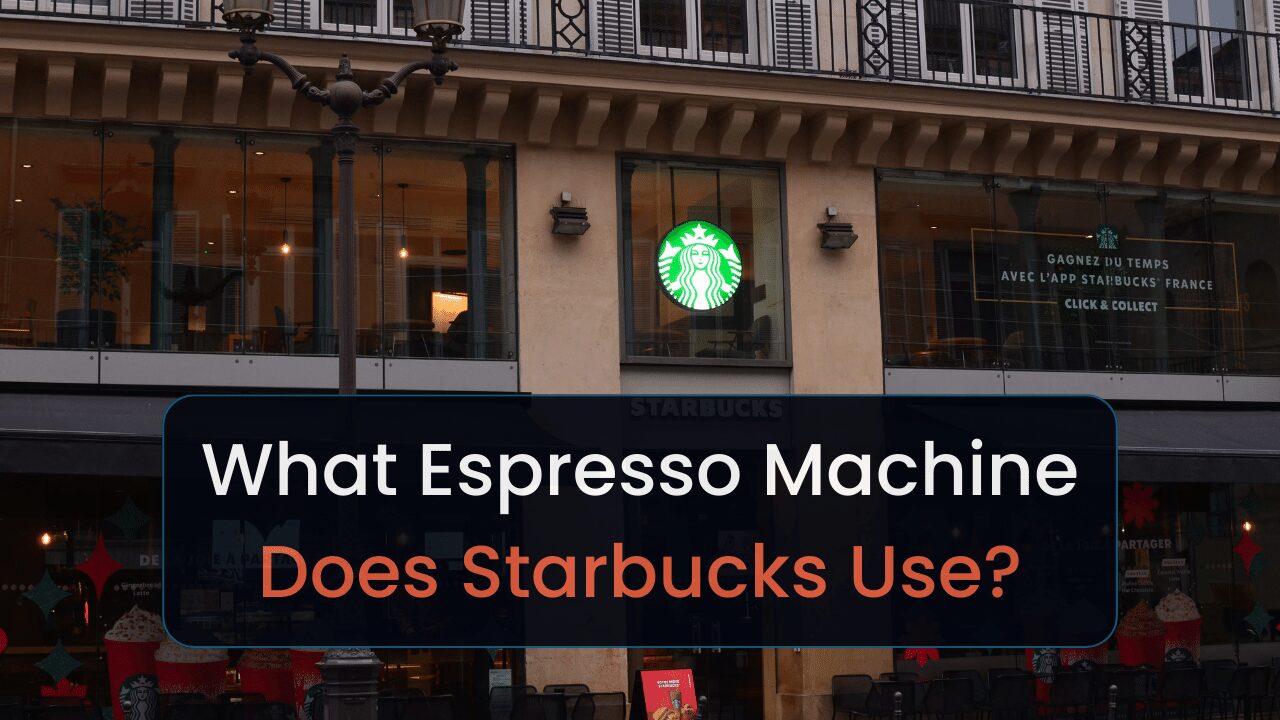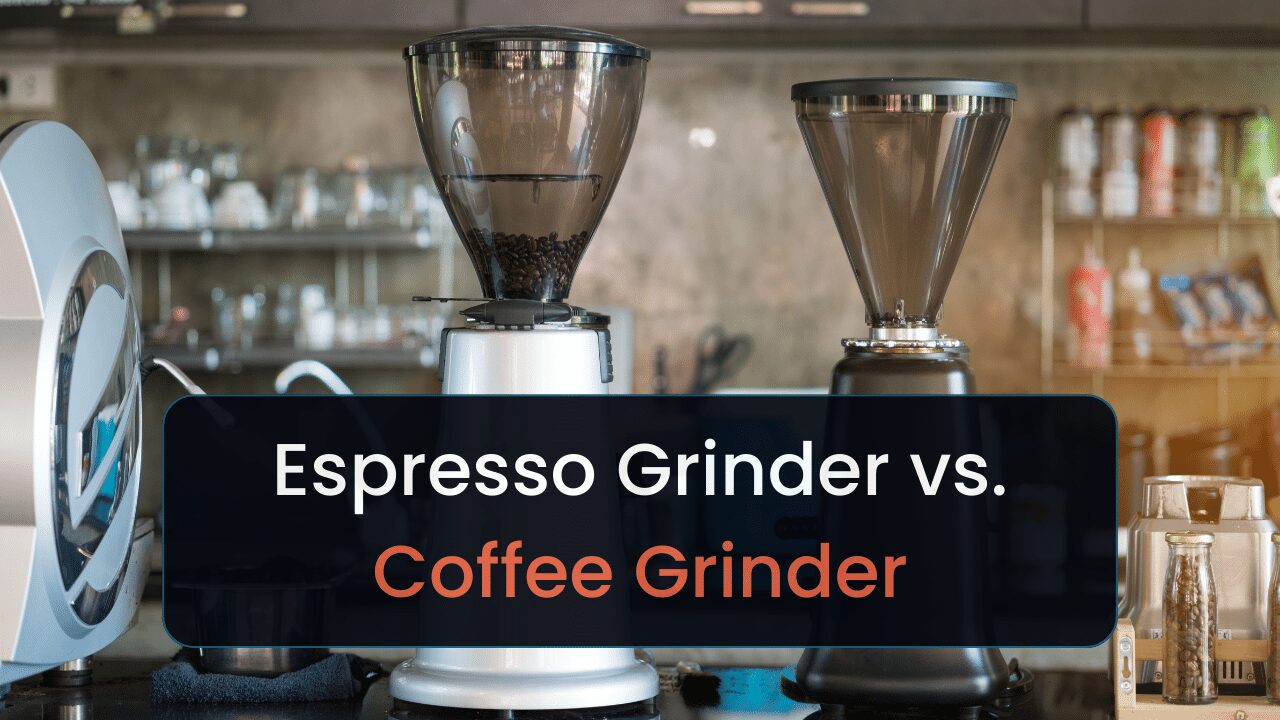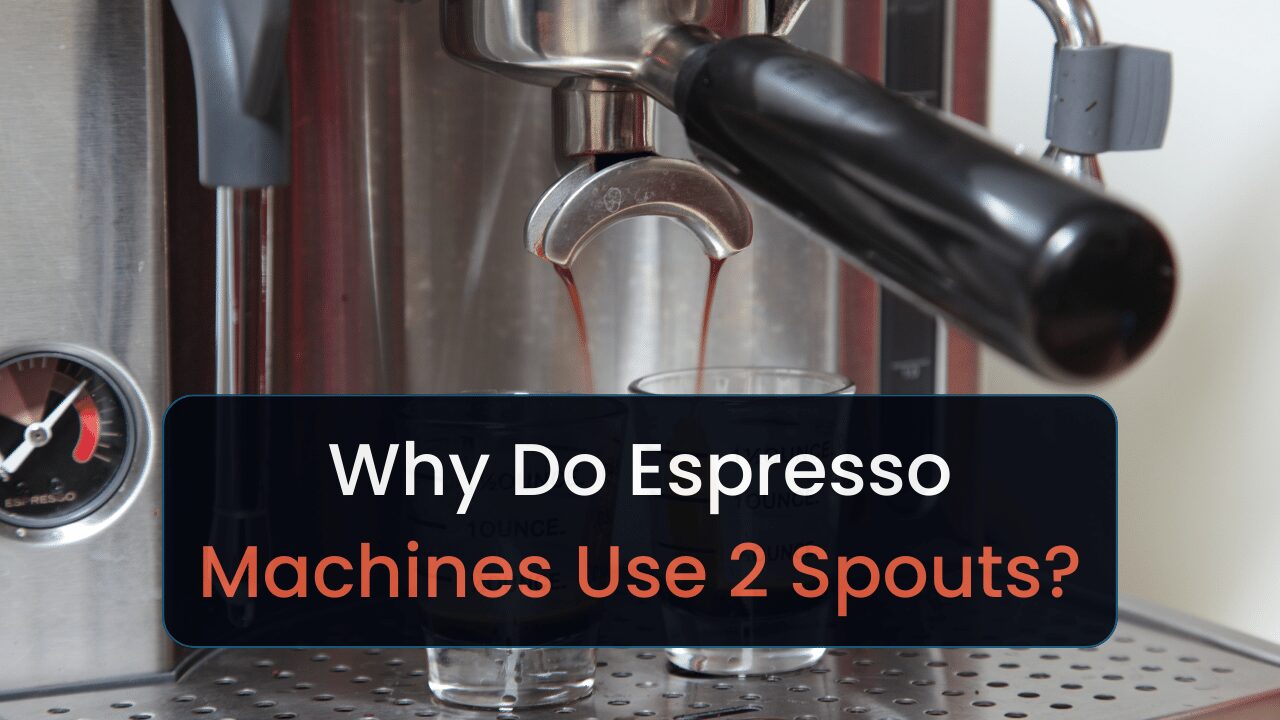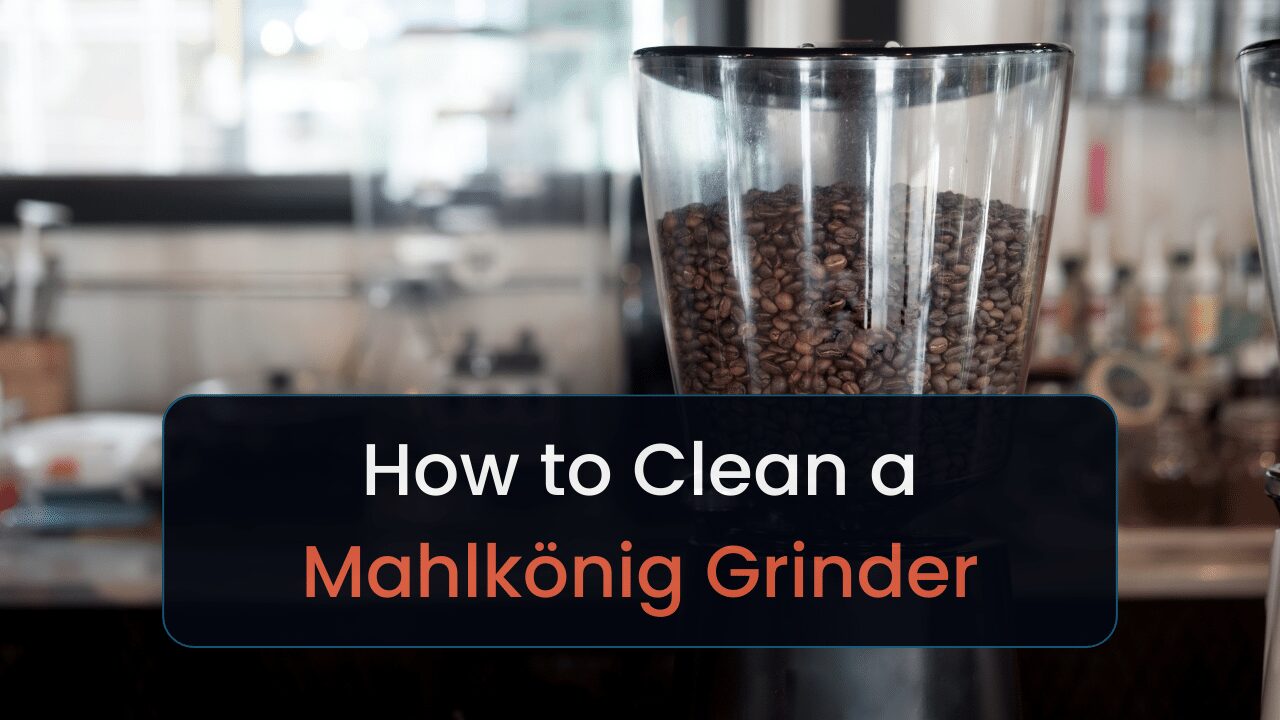This article is an overview of the best espresso machines made in Italy for home and business use. Read on to learn more.
I’m a former barista who wants to have an “authentic” Italian espresso. That’s possibly doable with an Italian espresso machine. And the reason I wrote this guide.
I chose the Rancilio Silvia as the best overall machine because it has commercial-grade components and supports ESE pods.
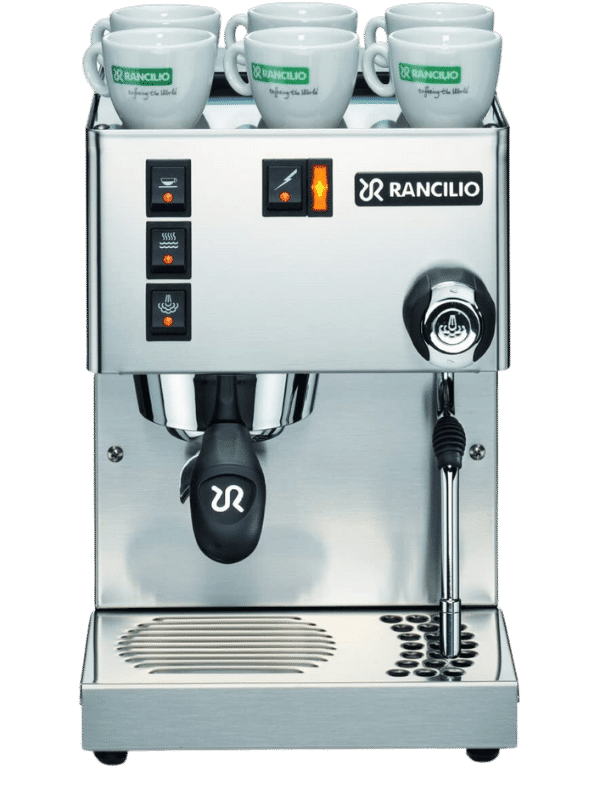
Rancilio Silvia: Best Overall
- Price: $$$
- For: Home Use
- Dimensions: 9.2 x 11.4 x 13.3 in (D, W, H)
- Water Tank Size: 10.4 fl oz = 10 solo shots
- Machine Type: Semi-automatic
- Warranty: 1 year
- Made In: Italy
Such features and design choices give you more variety when making coffee. Meanwhile, your machine will last around 1/10th of your life before requiring a replacement.
I’ll talk about whom each machine on this list is best for, their pros and cons, features, and other valuable tidbits.
Let’s get to it.
Top Italian Espresso Machines
- Rancilio Silvia: Best Overall
- Gaggia Classic Pro: Best under $1,000
- Gaggia La Giusta Tall: Best for commercial use
- Sanremo Cafe Racer: Best for busy coffee shops
- Gaggia Brera: Best Italian Espresso Machine With Grinder
- Illy Easy Coffee Machine: Best pod-compatible machine
- Lelit Bianca V3: Best prosumer machine
Best Italian Espresso Machines for Home & Commercial Use
The following sections will cover the advantages and disadvantages, features, and use case for each machine.
By “Italian” espresso machines, I refer to devices manufactured by Italian brands. It doesn’t mean that Italian machines are made in Italy. However, all machines I listed are made in Italy.
Without further ado, let’s go.
1. Rancilio Silvia: Best Overall

| Price | $$$ |
| For | Home Use |
| Dimensions (D, W, H) | 9.2 × 11.4 × 13.3 in |
| Water Tank Size | 10.4 fl oz = 10 solo shots |
| Machine Type | Semi-automatic |
| Warranty | 1 year |
| Made in | Italy |
Pros:
- High-quality construction
- Commercial-grade group head
- Supports ESE pods
Cons:
- Difficult to use
- Lacks temperature control
- Expensive
The Rancilio Silvia is an exceptional machine for any espresso enthusiast who wants a high-quality Italian machine, but doesn’t want to spend a fortune.
It’s a semi-automatic machine. Meaning, you’ll have control over most parameters when making espresso. However, you’ll need to master these machines to make good espresso.
It also has a single boiler without a heat exchanger or PID. Meaning it can’t heat water and froth milk simultaneously. I wouldn’t use this machine for entertaining groups. You’ll want a super-automatic machine for that.
It’s a bit expensive, but you’re paying for an espresso maker that has high-quality components. Many folks have claimed their Silvia lasted for more than 9 years [1]. That could save you money over time if you need to replace your machine annually.
The Silvia also uses a commercial-grade group head, which ensures your machine will have better thermal stability. And with this factor optimized, you’ll have drinks with more consistent temperatures.
But as I said, it doesn’t have PID, which means it won’t micromanage your temperature. But with that feature, this machine would have cost much more.
Do you want to use Easy Serving Espresso (ESE) pods? You could get an adapter kit and eliminate the need for a grinder. Saving you hundreds of dollars.
You may not have such a high budget. I have an alternative that’ll cost much less.
2. Gaggia Classic Pro: Best Italian Espresso Machine Under $1,000
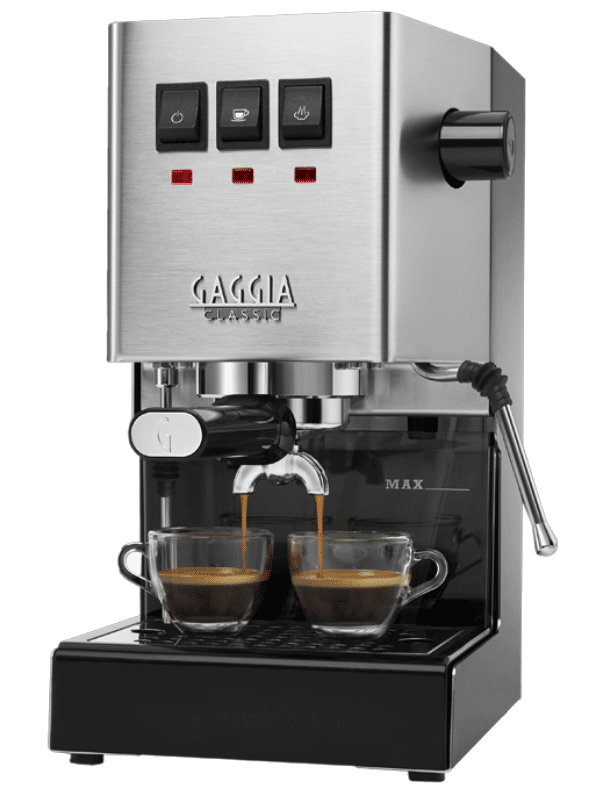
| Price | $$ |
| For | Home Use |
| Dimensions (D, W, H) | 8 × 9.5 × 14.2 in |
| Water Tank Size | 71 fl oz = 71 solo shots |
| Machine Type | Semi-automatic |
| Warranty | 1 year |
| Made in | Italy |
Pros:
- Professional-grade steam wand
- Durable and built to last
- Easy to operate
Cons:
- Single boiler design
- Lacking on accessories
- No temperature or pressure control
The Gaggia Classic Pro is a perfect machine for home baristas who are on a budget, yet want to make high-quality espresso drinks.
Again, it’s a semi-automatic machine with a single boiler. It can’t froth and brew simultaneously and will take more than 5 minutes to heat up. It also has quite a steep learning curve to use.
But this machine’s built to last. Some have claimed that this machine will last them for more than 10 years [2]. A feat that most machines in this price range can’t beat.
The portafilter for this machine isn’t compatible with ESE pods like with the Silvia. A bummer if you want to avoid buying a grinder. It also doesn’t have temperature management features like PID.
The commercial-grade steam wand offers full control over milk frothing. Since you can move it in every direction. This design choice allows you to get a milk foam with a better texture. And thus, a better taste.
The Classic Pro also includes a commercial-style spouted portafilter. That’s nice for ensuring longevity, but you may want to consider a bottomless portafilter for better troubleshooting if you get this device.
We compare spouted and bottomless portafilters in a separate guide.
Otherwise, the machine has only a few buttons. Making it easier to learn to use for beginner and intermediate home baristas.
Are you a business owner who’s wondering if I’ll recommend a machine for them? It’s your lucky day.
3. Gaggia La Giusta Tall: Best Italian Espresso Machine for Commercial Use
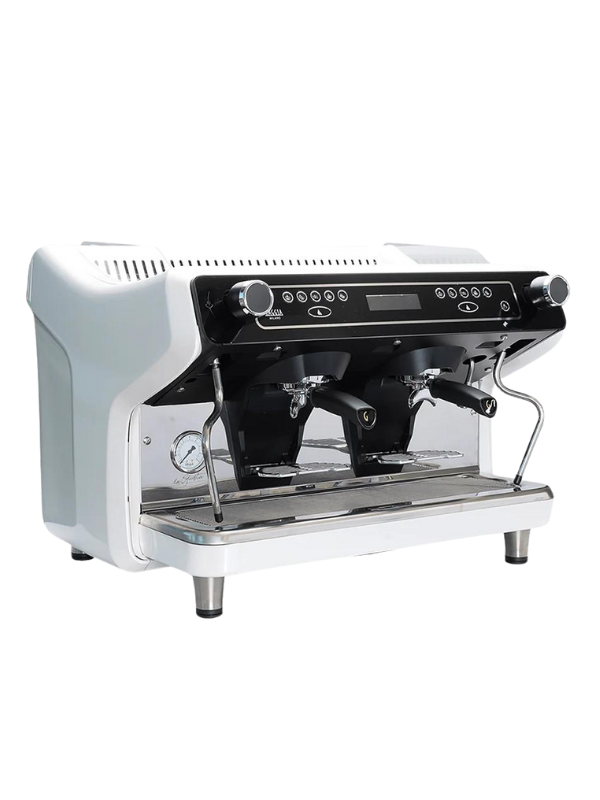
| Price | $$$ |
| For | Medium-sized business |
| Dimensions (D, W, H) | 25 × 29.9 × 21.5 in |
| Water Tank Size | 3.6–5.5 gal = 460–704 solo shots |
| Machine Type | Semi-automatic |
| Warranty | 1 year |
| Made in | Italy |
Pros:
- Volumetric dosing
- Excellent temperature control
- Allows brewing for taller drinks
Cons:
- Large and heavy
- Expensive
The Gaggia La Giusta Tall is a fantastic machine for businesses that want to serve 50–300 drinks daily.
It’s a semi-automatic espresso machine, which means most steps of espresso-making aren’t automated. But the machine has plenty of features (e.g., volumetric dosing), which makes it easier to use for new baristas.
Volumetric dosing that allows you to program the machine to dispense the perfect amount of espresso for each drink. This feature is excellent because it ensures that your customers will get consistent, high-quality beverages.
And if they need you to brew coffee in a taller cup, you could do so with the La Giusta Tall, since it has removable shot cupholders.
It, unlike previously mentioned machines, uses Proportional Integral Derivative (PID). It’s a type of feedback control loop used in espresso machines to maintain a consistent water temperature.
PID is an essential feature for coffee shops since it requires less maintenance than temperature controllers like manual thermostats. It also helps reduce waste since it prevents your baristas from under- and over-extracting your coffee.
Since it’s micromanaging your machine’s temperature.
Despite all the pros, the machine is large and heavy. It’s not ideal for coffee carts or small cafés and coffee shops. And its price tag makes it inaccessible for such businesses as well.
Do you need a more robust machine for your business? Keep reading.
4. Sanremo Cafe Racer: Best Italian Espresso Machine for Busy Coffee Shops
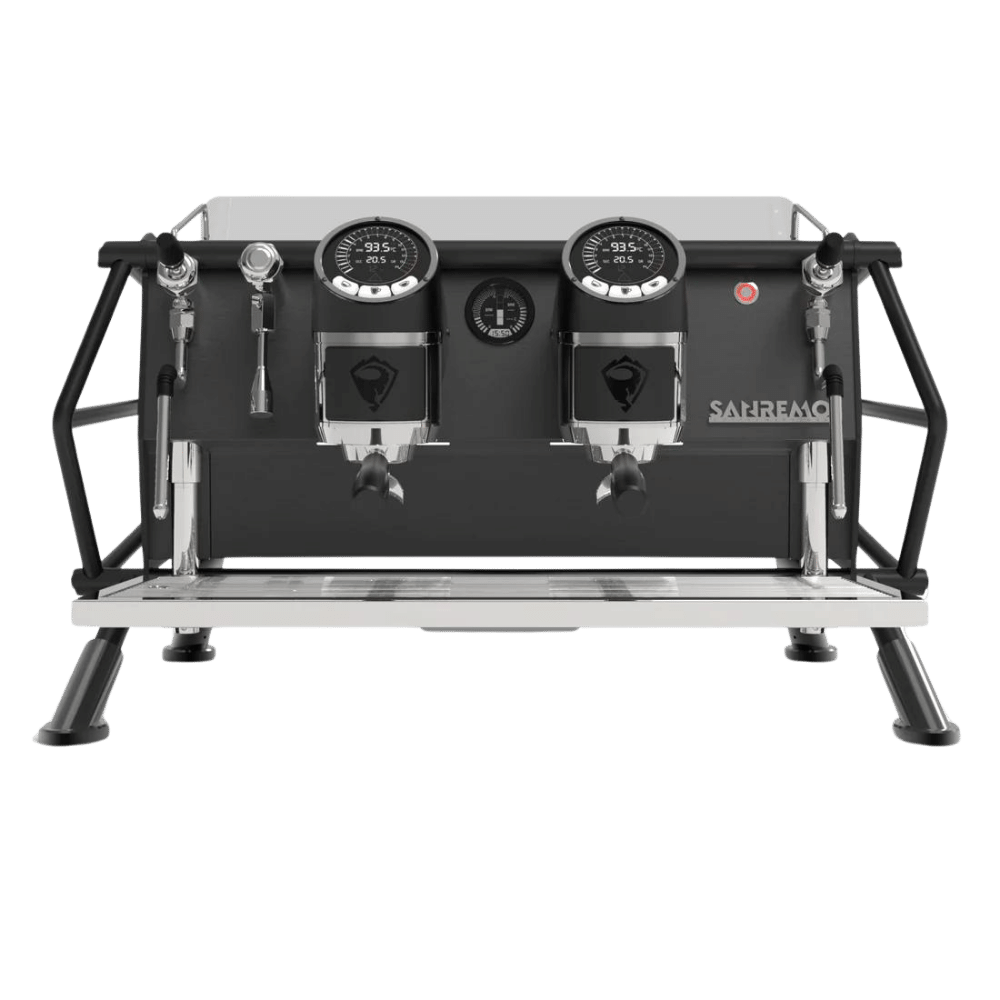
| Price | $$$$ |
| For | Coffee shops |
| Dimensions (D, W, H) | 27 × 34.5 × 21 in |
| Water Tank Size | Plumbed in |
| Machine Type | Semi-automatic |
| Warranty | 1 year |
| Made in | Italy |
Pros:
- Programmable volumetric controls
- Excellent temperature stability
- Will last for almost a decade
Cons:
- Cannot program multiple espresso profiles per grouphead
- Very heavy
The Sanremo Cafe Racer 2-group model is best for coffee shops and cafés that serve 50–300 customers daily. The 3-group model is better for serving 300–600 cups daily.
The number of cups daily isn’t representative of how many cups you’ll need to serve during a lunch rush. If you serve several hundred cups of coffee during a lunch rush, opt for a 3-group machine.
Otherwise, consider renting one of each group head type if possible to test them.
“X’-group” refers to the number of group heads your machine has. The more, the more customers you can serve.
Anyway.
Volumetric controls are a beneficial addition to busy coffee shops as they automate the espresso dispensing process, enhancing efficiency, consistency, and reducing waste. They shorten training time for new baristas and improve customer satisfaction by ensuring consistent drink quality.
It uses PID controllers on multiple boiling tanks, which ensures your beverages’ steam and water are always at optimal temperature levels for extraction. This helps in producing consistent drinks.
And many folks have claimed that this machine will last 7 to 10 years. Perfect for businesses who don’t want to continually dump money into replacements.
It’s not that fancy of a machine (technology-wise). Baristas can’t save different espresso profiles for different drinks. That’s not ideal if you serve a wide variety of beans.
This machine’s also super heavy. Meaning, you’ll need multiple people to move it.
You may be a home barista and want a machine that includes a grinder. Here’s a good option.
5. Gaggia Brera: Best Italian Espresso Machine With Grinder
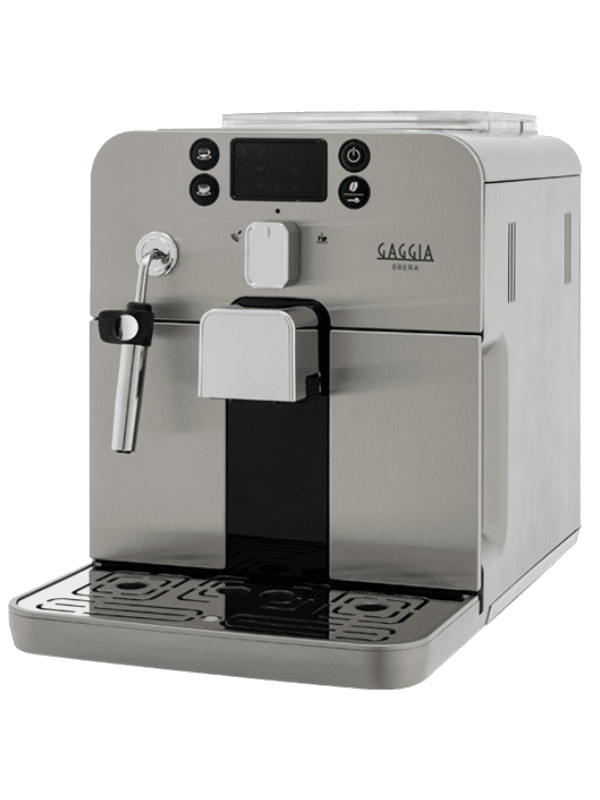
| Price | $$ |
| For | Home use |
| Dimensions (D, W, H) | 10 × 15.5 × 11.5 in |
| Water Tank Size | 40 fl oz = 40 solo shots |
| Machine Type | Super-automatic |
| Warranty | 1 year |
| Made in | Italy |
Pros:
- Easy to use
- Reasonable price
- Front-loading reservoir
Cons:
- Not the best grinder
- Less premium (plastic exterior)
- Uses a single boiler
The Gaggia Brera is an ideal machine for homes who want to entertain a guest or 2. And who doesn’t want to learn how to make authentic espresso.
It’s a super-automatic machine, which means it’ll perform every step of the espresso-making process for you. And the Brera has a single boiler. You’ll know it can’t froth and brew simultaneously if you’ve read the previous sections.
The single boiler makes this machine more affordable, though. You won’t find many Italian super-automatic espresso machines priced this low. However, the cheap-feeling plastic casing contributes to this machine’s affordability.
But that doesn’t matter if you take good care of the Brera.
Gaggia’s super-automatic machine uses a steel conical burr grinder. It’s not as consistent as grinders that use flat burrs. And the steel burrs may heat up and damage the beans. But it could save you a lot of money in space than if you bought a separate grinder.
The front-loading water reservoir and coffee grind dreg box make this device a perfect addition to many kitchens. You could place it under wall cabinets without needing to move it. Since you won’t need to reach behind the machine to add water.
The steam wand heats in under 10 seconds, which makes it less time to brew drinks. However, since it’s automated, it doesn’t offer the most control over your milk’s texture. But you’re after automation with this machine, not control.
Do you want even more automation? Keep reading.
6. Illy Easy Coffee Machine: Best Pod-Compatible Italian Espresso Machine
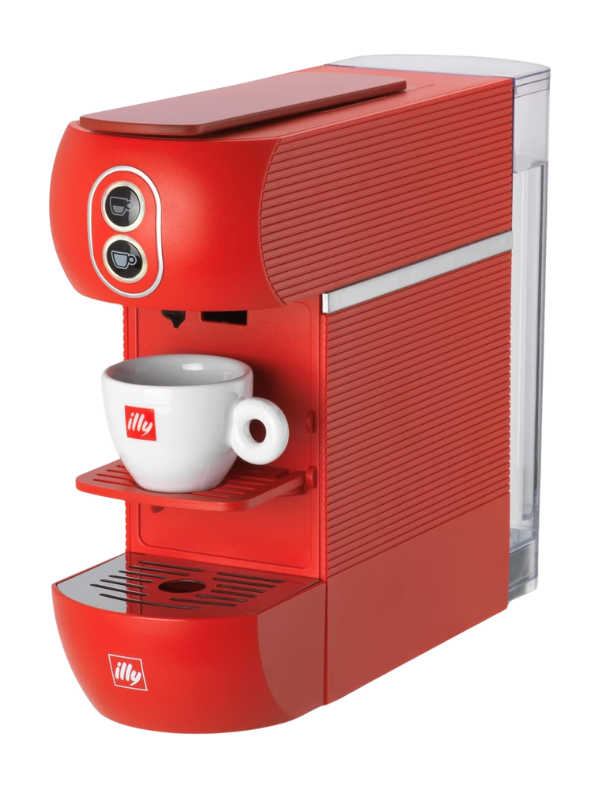
| Price | $ |
| For | Offices, college dorms, and home |
| Dimensions (D, W, H) | 10.2 × 4.33 × 12.5 in |
| Water Tank Size | 33 fl oz = 33 solo shots |
| Machine Type | Pod |
| Warranty | 1 year |
| Made in | Italy |
Pros:
- Compact
- No learning curve required
- Affordable machine
Cons:
- Doesn’t use Nespresso pods
- Limited beverage options
- Limited pod availability
The Illy Easy Coffee Machine works best for anyone that wants a single-serve Italian espresso machine.
It’s technically a capsule machine, but it uses Easy Serving Espresso (ESE) pods instead of Keurig’s K-Cups, TASSIMO’s T-Discs, or Nespresso pods. That means it’ll automate the entire espresso brewing process.
ESE pods are pre-filled pods that allow you to brew coffee in espresso machines with ESE adapters on portafilters. Thus, many semi-automatic espresso machines can use these too. And these pods cost $0.33–$0.60 per serving [3].
Making them more affordable than Nespresso and many Keurig pods.
But ESE pods don’t have as many pod options. Since it’s only ground coffee, you don’t have pods with tea or sweetened coffee drinks. And you don’t have access to beverages like black coffee like with Nespresso Vertuo and Keurig machines.
There’s also no milk frother included. You’d need to buy a separate one to brew drinks like cappuccinos. If you want to do this on a budget, consider an immersion blender—they’re cheap, like this machine.
We talk about other ways to froth milk without using an expensive frother in a separate guide. Check it out.
Despite the cons, this machine will easily fit in small kitchens, RVs, in college dorms, or in offices. And it doesn’t have a learning curve to use. You add a pod, press one of 2 buttons, and brew.
You may be a home barista looking for the highest-quality Italian espresso machine. You’ll want to check out our last pick.
7. LELIT Bianca V3: Best Prosumer Italian Espresso Machine
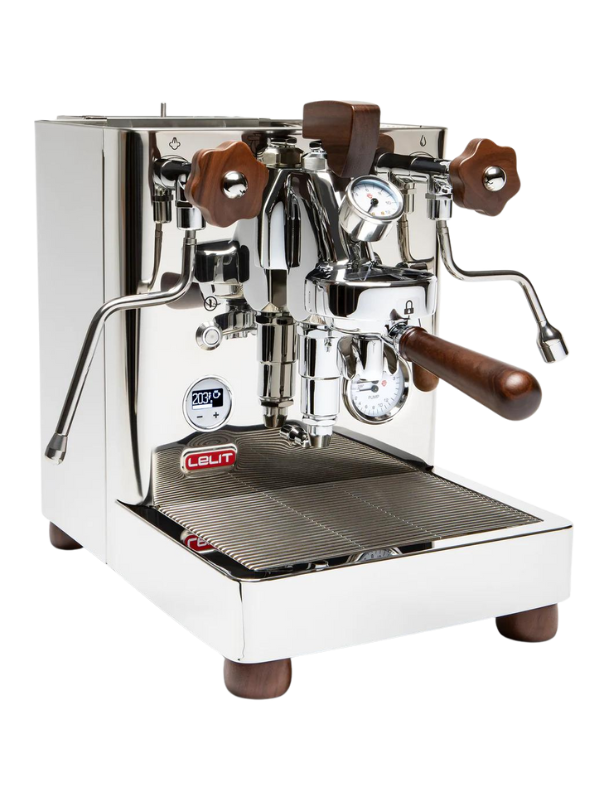
| Price | $$$ |
| For | Enthusiasts at home |
| Dimensions (D, W, H) | 19.1 × 11.4 × 15.75 in |
| Water Tank Size | 84 fl oz = 84 solo shots |
| Machine Type | Semi-automatic |
| Warranty | 1 year |
| Made in | Italy |
Pros:
- Heats up quicker than other E61 machines
- Can connect to home’s plumbing
- Uses a dual boiler
Cons:
- Cup riser is too small
- No water tank indicator level
- Machine automatically powers off after 30 min
The LELIT Bianca V3 is an optimal machine for espresso hobbyists and enthusiasts who want to produce an authentic Italian espresso from home.
It’s a semi-automatic machine. If you’re still reading, you likely already know it requires skill to use this machine type. And it uses a dual boiler with PID, which allows you to froth milk and brew espresso at the same time.
The PID controller micromanages the temperatures of both water tanks, which provides optimal temperatures for your frothed/steamed milk and espresso. Thus, no complaints regarding temperature consistency.
Since you’re going hard with espresso making, you might as well directly connect this to your home’s plumbing and add a water filter. That way, you’re using the best water possible for your drink.
Most espresso machines with E61 group heads take a long time to heat up—up to 16 minutes. However, this machine takes around 10 minutes. Allowing you to start brewing your espresso quicker.
But the machine will power off completely after 30 minutes of heating its tank. Requiring you to brew coffee within that time frame or suffer the consequences of needing to reheat your Bianca.
The cup riser is also a bit small, which means you’d need to hold a scale on it if you want to place a scale and espresso shot on your riser.
And there’s no way to tell how much water is left in your water tank. You’ll need to reach behind the machine to access the tank and check the water levels. A bit of a pain if you place this under a wall cabinet.
But if you have this thing connected to your home’s plumbing, this complaint becomes null.
That’s all for our recommendations. Keep reading to know whether you’re buying the right machine.
Italian Espresso Machine Buying Guide
Consider these factors when shopping for an Italian espresso machine:
| Factor | Description |
| Brand | Determines customer support and device quality. |
| Features | Can improve taste and make brewing easier. |
| Machine Type | Determines automation and price. |
| Water Tank Size | Amount of drinks you can make before refilling |
| Price | What you’ll pay for the machine. |
I’ll provide details on each factor below. Keep reading to learn more.
1. Italian Espresso Machine Brands
Prioritizing reputable brands is crucial for ensuring a high-quality brewing experience that authentically replicates traditional Italian espresso’s rich, full-bodied flavor.
Leading Italian espresso machine brands possess deep-rooted knowledge and expertise in traditional espresso brewing methods.
They understand the nuances of pressure, temperature, and brewing time essential for producing espresso with its signature crema and flavor profile.
Renowned brands typically have long-lasting machines due to having strict quality controls. Meaning that your machine will last for years before requiring a replacement.
They also value customer satisfaction and provide comprehensive support services. That’s essential for anyone who could have issues with an expensive espresso machine they just bought.
Here are some of the Italian espresso brands you’ll find:
| La Marzocco | Rancilio | Rocket Espresso | ECM |
| LELIT | Bezzera | Gaggia | Rancilio |
| Victoria Arduino | Nuova Simonelli | Dalla Corta | ILLY |
| La Pavoni | La Spaziale | De’Longhi | Sanremo |
| Elektra | Casadio | Wega | Faema |
| Isomac | Lavazza | La Cimbali | Saeco |
| Vibiemme (VBM Espresso) |
Features that many of these brands make will also differ. Let’s see how.
2. Features
Consider these features when shopping for Italian espresso machines:
| Feature | Description |
| PID | Maintains consistent brewing temperature for optimal espresso extraction |
| Pre-infusion | Slowly saturates coffee grounds before full pressure extraction for even extraction and balanced flavor |
| Commercial-grade pump | Delivers consistent high pressure for rich crema and optimal espresso extraction |
| Removable water tank | Easy to fill and clean, promoting hygiene and convenience |
| Dual-wall portafilter | Maintains heat and prevents temperature loss for consistent espresso extraction |
| Precision steam wand | Produces smooth, microfoam milk for latte art and creamy cappuccinos |
| User-friendly controls | Intuitive and easy to use, ensuring effortless espresso preparation |
Many higher-end Italian espresso machines will include PID. But this feature only works well with devices with 2 boilers. That’s because the PID will control the temperatures of both tanks. Ensuring consistent temperatures for steam and water.
Almost all Italian machines, except some super-automatic makers, will include steam wands.
Many consumer-grade makers will include removable water tanks. But from what I’ve seen, many Italian espresso machines—even the cheaper ones—don’t have removable tanks. That makes refilling and cleaning water reservoirs a bit more annoying.
Higher-end home or commercial machines will use rotary pumps instead of vibratory pumps. These machines cost much more but last longer and have a more consistent water flow.
You’ll find pre-infusion on many medium- to high-end machines.
Also, the machine type will determine what features you’ll find.
3. Machine Type
Italian espresso machines typically come in one of the following forms:
| Machine Type | What it Automates | Best for | Price |
| Super-automatic | Everything | Automated traditional espresso | $700–$10,000 |
| Semi-automatic | Pressure & water flow | Graduating from manual machines | $200–$10,000 |
| Automatic | Grinding, tamping, & brewing | Balancing cost & automation | $700–$10,000 |
| Capsule | Everything | Convenience, cost, & speed | $100–$500 |
Super-automatic machines work best for anyone entertaining guests or who doesn’t want to develop a skill to brew a great-tasting drink. Capsule machines are the same, but also don’t require grinding beans.
However, there aren’t many capsule machines made by Italian brands.
Semi-automatic machines are the most common device type made by Italian brands. They’re ideal for enthusiasts and hobbyists with extra time and the patience to learn the art of making espresso.
Italian automatic machines aren’t common, but they’re great for balancing cost and automation.
You’ll also need to consider how many drinks you can serve before refilling.
4. Water Tank Size
Italian espresso machines have water tanks, typically ranging from 60 to 80 ounces. They can accommodate multiple espresso shots and milk steaming sessions without frequent refills.
This is convenient for households with multiple espresso enthusiasts or those who enjoy preparing multiple beverages at once.
Smaller water tanks, typically ranging from 30 to 40 ounces, may require more frequent refills, especially if you plan to prepare multiple espresso drinks or steam milk for cappuccinos or lattes regularly.
Machines with smaller reservoirs will generally fit better in smaller kitchens due to having a small size, though.
Water reservoir capacity, along with other factors, will determine your machine’s price.
5. Price
You’ll find plenty of high(ish)-end Italian espresso machines under $1,000 (e.g., Gaggia Classic Pro). These devices won’t have prosumer features such as dual boilers or rotary pumps, though.
But they’ll make excellent-tasting espresso.
Prosumer models will range from $1,000 to $5,000. These devices typically use the highest-quality components and include various features like what I mentioned.
Commercial Italian espresso machines will cost more than $5,000. These devices will usually connect directly to your building’s plumbing, include multiple group heads, and have other features that’ll ensure it withstands constant use.
What drinks can all these espresso makers produce? Read on to find out.
6. Drinks It Can Make
Most Italian espresso machines can brew the following types of beverages:
| Americano | Red Eye | Espresso shots |
| Black Eye | Mocha | Irish Coffee |
| Cappuccino | Macchiato | Lazy Eye |
| Latte | Flat White | Doppio |
| Ristretto | Lungo |
As you see, there’s no black coffee. That’s because they’re all “espresso” machines.
Most, but not all, Italian espresso machines will produce milk-based drinks like lattes and flat whites. Few super-automatic machines won’t include milk frothers or steam wands. Limiting them to making Americanos, lungo, doppio, ristretto, and regular espresso shots.
Unless you buy a separate milk frother.
Are you an aspiring business owner? Keep reading.
7. What Businesses Should Consider
Business owners will also want to consider the following factors when shopping for an espresso machine:
- Number of group heads: Determines how many customers you can serve.
- Certifications: Whether they’re legal to use in a coffee shop.
- Boiler type: How fast your machine will heat up.
- Electrical connection: Whether you’ll need to hire an electrician.
- Temperature stability: How consistent your machine’s temperature sits.
I go more in-depth with these factors and more in a separate guide, where we cover what businesses should consider when shopping for an espresso machine.
These features are essential to consider since you’ll serve potentially hundreds of customers daily. Thus, Italian espresso machines will need to withstand all that use while producing consistent, high-quality espresso.
There’s nothing more to cover. Let’s review our top picks.
Conclusion
Here are the top picks:
- Rancilio Silvia: Allows for use of ESE pods.
- Gaggia Classic: Affordable.
- Gaggia La Giusta Tall: Automates espresso making.
The Rancilio Silvia is the best overall machine because it’s durable to last almost a decade, but could save you money otherwise spent on a grinder if you opt for ESE pods.
Do you not like any of these espresso machines? Consider our other recommendations for Italian and non-Italian espresso makers.

Rancilio Silvia: Best Overall
- Price: $$$
- For: Home Use
- Dimensions: 9.2 x 11.4 x 13.3 in (D, W, H)
- Water Tank Size: 10.4 fl oz = 10 solo shots
- Machine Type: Semi-automatic
- Warranty: 1 year
- Made In: Italy

